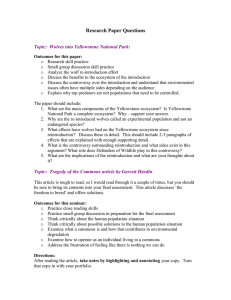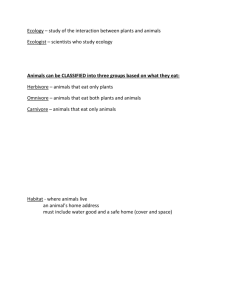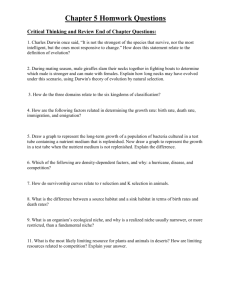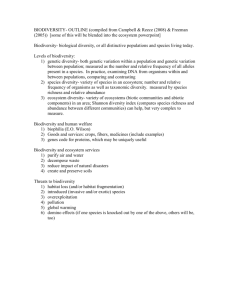Chapter 13: Ecology Review Sheet What is the definition an
advertisement
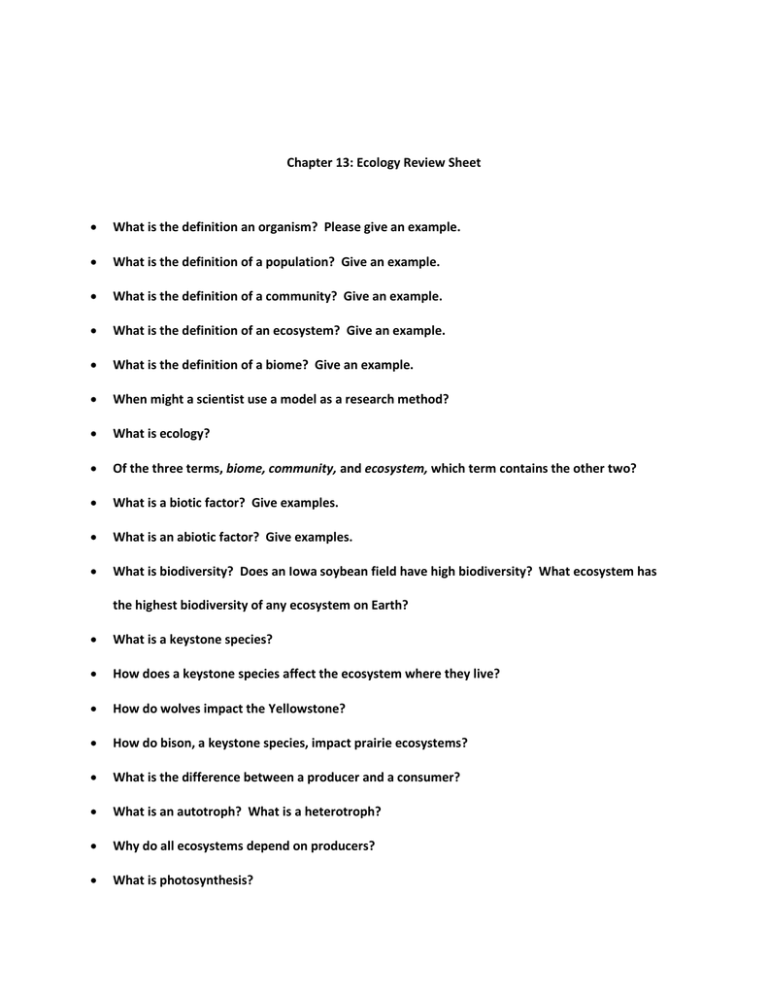
Chapter 13: Ecology Review Sheet What is the definition an organism? Please give an example. What is the definition of a population? Give an example. What is the definition of a community? Give an example. What is the definition of an ecosystem? Give an example. What is the definition of a biome? Give an example. When might a scientist use a model as a research method? What is ecology? Of the three terms, biome, community, and ecosystem, which term contains the other two? What is a biotic factor? Give examples. What is an abiotic factor? Give examples. What is biodiversity? Does an Iowa soybean field have high biodiversity? What ecosystem has the highest biodiversity of any ecosystem on Earth? What is a keystone species? How does a keystone species affect the ecosystem where they live? How do wolves impact the Yellowstone? How do bison, a keystone species, impact prairie ecosystems? What is the difference between a producer and a consumer? What is an autotroph? What is a heterotroph? Why do all ecosystems depend on producers? What is photosynthesis? How are consumers dependent on the sun? What is the difference between photosynthesis and chemosynthesis? What are the four main types of consumers? What is an herbivore? What is a carnivore? What is an omnivore? What is a detritivore? What does a decomposer (they are detritivores) do? What is the difference between a specialist and a generalist? What are the trophic levels in a food web or a food chain? What is the difference between a food chain and a food web? Describe the flow of energy from one trophic level to another in a food web? How does habitat differ from the concept of ecological niche? Know the definitions of habitat and niche that I gave in class. What would the habitat be for a jaguar living in the Amazonian rainforest? What would the jaguar’s niche be? What is symbiosis? Please think about the cases of symbiosis we have seen in class. How are the leaf cutter ants and the fungus they cultivate an example of symbiosis? What is coevolution and how is it connected with symbiosis? Again, please be able to connect the term coevolution to the examples we talked about in class. What is an evolutionary arms race? How is the relationship between the garter snake and the poisonous newt an example of an evolutionary arms race? Think of other examples of evolutionary arms races – especially one involving people, which we saw in the video from Monday. Yellowstone Video: Concepts • • • This video tied a number of concepts together. – Research – field work and application of science. – Biotic and abiotic factors – Populations, communities, ecosystems, etc. – Keystone species – Biodiversity How did the Yellowstone ecosystem change with the reintroduction of the wolves? – What was the condition of the park’s habitat (range) before wolf reintroduction? – How did the park’s habitat change after there reintroduction? What role do wolves play in the Yellowstone ecosystem? – • How do the wolves affect the other parks species? Why do we call them a keystone species? Unit 13.3 Review Questions • How does the stability of an ecosystem depend on its producers? • What are the two processes used by producers to obtain energy? • Few producers live deep below a lake’s surface, create a hypothesis that explains this fact. • Could producers survive without consumers? Explain why or why not. • How might chemosynthetic organisms help scientists to understand how life developed on Earth?
